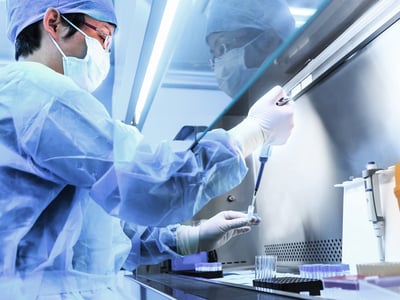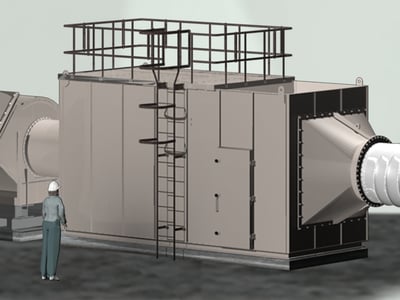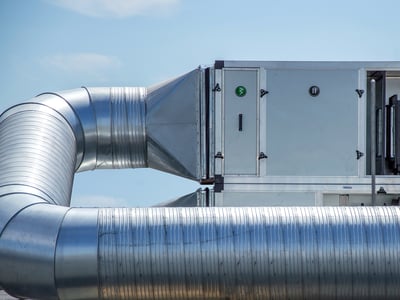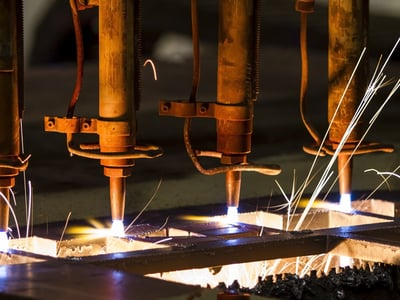During the production of lithium ion batteries many different airborne contaminants are generated that can affect the health of workers. Ensuring that these airborne contaminants are removed and captured from your facility is critical to the safe operation of your production facility.
The most critical environmental item to be controlled in battery production facilities is relative humidity, sometimes as low as a dew point temperature of -70º celsius. In order to maintain this level, the rooms must be sealed to prevent the introduction of any moisture. For lithium Ion battery cells clean materials account for 85% of that pack process materials cost. Reducing contamination through all stages of the manufacturing process will significantly increase the yield, which has been known to be 50% when contaminant levels are not controlled properly. Increased yield and better performing cells will foster the market’s acceptance of this new technology. Improving and maintaining air class inside the building will increase yield and produce better performing cells this will improve productivity and promote faster adaptation of this transport mode.
Different types of lithium-ion batteries use different chemistries and have different performance, cost, and safety characteristics. The cells of a lithium-ion battery contain separators that keep the anodes and cathodes, or positive and negative poles, from touching each other. If a piece of metal gets too close to the separator, it can puncture the separator and cause a short circuit. Controlling the air quality during the manufacturing process reduces this costly contamination, increases yield and assures that a quality product will make its way to the user. Camfil clean air solutions will protect your processes by reducing the airborne contaminants that foul or short circuit cells. Yield is increased and a quality product is packaged for the user
During the production of Lithium-ion batteries different particulates, gases and toxins are created that can cause a risk to both the people within your factory and external stakeholders. Ensuring that the health of all stakeholders is properly addressed will ensure a safe working environment. Camfil clean air solutions can help to capture and remove these potentially harmful contaminants in the air to ensure a safe and clean working environment.
Reducing energy costs and becoming “Net Carbon Zero” is a key initiative of many of the worlds leading brands. Did you know that HVAC systems can equate to over 50% of your total energy consumption and of this 30% can be directly related to the air filter? Camfil clean air solutions are designed to ensure your plant is energy optimised without compromising on air quality.

Controlled environments must protect critical processes and personnel. A high level of air cleanliness is essential to protect products and to contain hazardous compounds. High-quality filtration systems help ensure regulatory compliance and maintain efficient operations.

Protect the environment and people from dangerous or high concentrations of particles and molecules released by industrial processes, comply with local safety regulations and reduce operating costs of your exhaust air filtration system.

Protect people, processes, products and equipment while keeping maintenance and energy costs low by keeping air handling units unclogged.

Battery cell production involves new manufacturing processes based on laser technology that generates dust & fume which that must be extracted in a controlled manner to eliminate the risk of contamination and harm to the personnel.

CamCarb XG Engineered for energy and maintenance cost savings in molecular contamination control applications
Food and beverage Electronics and optics Commercial and public buildingsIn the realm of controlled environments, where precision, purity, and protection are paramount, High-Efficiency Particulate Air (HEPA) filters emerge as unsung heroes
Food and beverage Life science and healthcare Sustainability Education and experienceLearn more on how Camfil´s GoldLink Connect remote monitoring system helped a metalworking company to significantly reduce power consumption and compressed air consumption on their dust collectors.
Processes in manufacturing facilities often generate dust and fumes which for example can pose health risks for your operators or compromise the quality and safety of your products. Determining the right capture and filtration solution helps to protect against the main risks of uncontrolled emissions and thus to create safe work environments.
What are some of the challenges moving forward to achieve healthy and energy-efficient indoor air environments? And what are some of the new air filtration solutions that could potentially become a reality in the years to come?
Without HEPA filters, we would not be able to manufacture computers, medicine and many other products that are essential in today’s world. But what is the history of these High Efficiency Particulate Air filters and how and where are they used?
When purchasing dust collection systems and filter cartridges, the initial purchase price is just the tip of the iceberg. The true costs – energy, consumables and operations – are lurking below the surface. The good news is that there are ways to reduce these costs over the long term.
HemiPleat is, in short, the uniquely, patented media pleating technology Camfil use to create highly efficient filter cartridges that outlast and outperform competitors alternatives.
Dust collection systems are an important part of any manufacturing process, so they need to be sized and designed properly. One critical design component is specifying the proper filtration media, which requires analysis of the dust in the process and all operating conditions.
Dust collection systems are all safety devices and thus state-of-the art modern methods of validation and certification are required. Furthermore it is vital to ensure that the system is still in compliance after perhaps changed process conditions, to provide maximum safety for personnel and the facility. It is also recommended to carry out quality audits, process reliability surveys and annual safety inspections.
Not all people who purchase our products are experts in air filtration and they shouldn’t have to be either. The purpose of Camfil City is to give everyone a chance to learn the basics of what our clean air solutions can do for them.